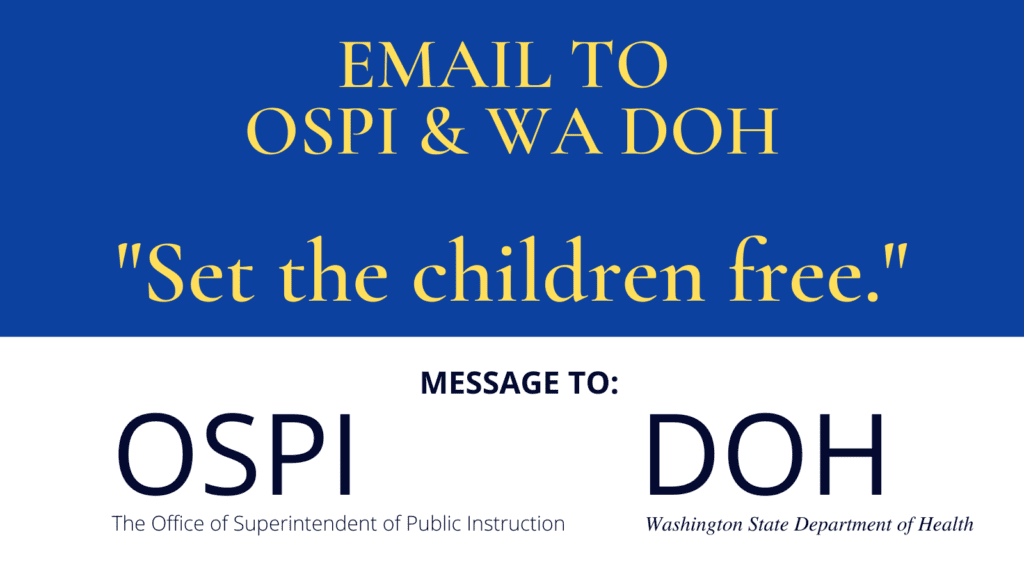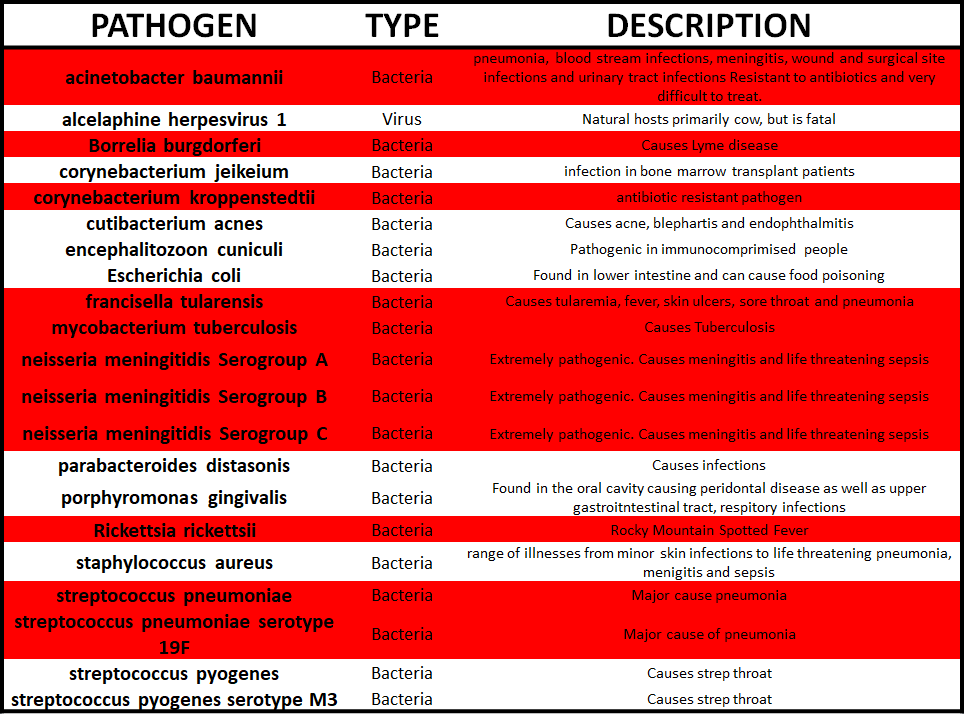The below information was emailed to: Chris Reykdal, Washington State Superintendent of Public Instruction; Dr. John Dunn, Medical Director for Preventative Care, Kaiser Permanente; SheAnne Allen, COVID-19 Vaccine Director, Washington State Department of Health Dr. Scott Lindquist, Acting State Health Officer for Washington State
UPDATE: We have not received a reply from anyone at OSPI or DOH regarding our grave concerns. We have, however, heard from both offices regarding our use of their logos, saying “Because the inclusion of the logo in your material erroneously implies that DOH is a sponsor/supporter of the message, DOH will not consent to its use in this manner.” OSPI used identical language.
ICWA has removed the logos, although it hardly seems necessary given that nobody could possibly have thought this post was in anyway sponsored or supported by either DOH or OSPI. We said to them that we “find it disturbing that DOH so quickly responded to concerns about their “brand” image, but has not responded to our grave concerns for our children’s health and safety.”
EMAIL TEXT:
Dear Chris Reykdal, Dr. John Dunn, SheAnne Allen, & Dr. Scott Lindquist
Today (June 16), you will be presenting an online “Conversation” about the upcoming school year, vaccination, and masks.
As Public Policy Director of Informed Choice WA, I want to be sure you are aware certain important facts since they should impact your decisions about the coming school year.
Unprecedented numbers of adverse reactions and deaths have been reported to VAERS following exposure to the investigational COVID-19 vaccines (biologics). This week VAERS is reporting 6,246 deaths and 337,226 injuries. While VAERS data cannot be used to establish causality or frequency of events, it can be used to find red flags and safety signals. Reports include:
-
- Deaths Within 0-2 Days of Injection – 2,338 (+297 From Previous Week)
- Spontaneous Miscarriages – 652 (+81 From Previous Week)
- Deaths In Low Risk Ages (0 to 39) – 159 (+18 From Previous Week)
- Deaths In High Risk Ages (60 & Up) – 3,899 (+247 From Previous Week)
- People Hospitalized Post Inoculation – 19,597 (+705 From Previous Week)
- Emergency Room Visits – 43,848 (Not Reported Previously)
- Life Threatening – 5,884 (+223 From Previous Week)
- Permanent Disability – 4,583 (+284 From Previous Week)
- Heart Attacks – 2,190 (+298 From Previous Week)
- Heart Attacks 0 to 24 Age – 46 (+8 From Previous Week)
- Bell’s Palsy – 1,737 (+172 From Previous Week)
- Severe Allergic Reaction – 15,052 (+1,478 From Previous Week)
- Stroke – 3,260 (As of 6.11.2021)
- Paralysis – 2,419 (As of 5.7.2021)
- Data Source – https://wonder.cdc.gov/vaers.html
-
- between 0.1%-1.9% of all child COVID-19 cases resulted in hospitalization
- Children were 0.00%-0.23% of all COVID-19 deaths, and 8 states reported zero child deaths
- In states reporting, 0.00%-0.03% of all child COVID-19 cases resulted in death
- SOURCE: https://services.aap.org/en/pages/2019-novel-coronavirus-covid-19-infections/children-and-covid-19-state-level-data-report/
-
- Mask-wearing by symptom-free individuals for hours a day, every day, is a massive human experiment. It is known that surgical and cloth masks cannot block viruses, and that if not worn and used very carefully, masks can and do cause harm.
- Scientific Reports of Harms Caused by Face Masks: see https://www.informedchoicewa.org/news/scientific-reports-of-harms-caused-by-face-masks/
- Review by Denis G. Rancourt (provided in link above) includes: physiological impacts of face masks; psychological harm in the general population; infants and school children; microbial pathogen from masks
- “During the pandemics caused by swine flu and by the coronaviruses which caused SARS and MERS, many people in Asia and elsewhere walked around wearing surgical or homemade cotton masks to protect themselves. One danger of doing this is the illusion of protection. Surgical facemasks are designed to be discarded after single use. As they become moist they become porous and no longer protect. Indeed, experiments have shown that surgical and cotton masks do not trap the SARS‐CoV‐2 (COVID‐19) virus, which can be detected on the outer surface of the masks for up to 7 days. Thus, a pre‐symptomatic or mildly infected person wearing a facemask for hours without changing it and without washing hands every time they touched the mask could paradoxically increase the risk of infecting others.” Isaacs D, Britton P, Howard-Jones A, et al. Do facemasks protect against COVID-19?. J Paediatr Child Health. 2020;56(6):976-977. doi:10.1111/jpc.14936
- “Conclusions This study is the first RCT of cloth masks, and the results caution against the use of cloth masks. This is an important finding to inform occupational health and safety. Moisture retention, reuse of cloth masks and poor filtration may result in increased risk of infection.” https://bmjopen.bmj.com/content/5/4/e006577
- An Oregon girl lost her pulse for four minutes after playing basketball with a face mask. “The ER doc looked me in the eye,” Jessica Lay [mother] said, “and said, ‘This is from the mask. It’s an isolated incident. This is not due to her health, it’s from extreme physical activity and having an obstruction of oxygen.’” https://www.oregonlive.com/highschoolsports/2021/05/mother-calls-for-change-in-oregon-high-school-sports-mask-rules-after-daughter-collapses-at-basketball-tryouts.html
- It is impossible for the general public, and especially children, to safely wear face masks for any length of time. They are continually touched, hands are not washed, the masks are not replaced when they become damp.
- The psychological and emotional impact of continuous face mask wearing is undermining the development and health our children. The risks of the masks — which are Emergency Use Authorized only — far exceed any perceived benefit, especially for children who are not at risk of poor outcome to COVID-19.
-
- Unprecedented numbers of adverse reactions and deaths reported to VAERS following exposure to the vaccines.
- Independent doctors are reporting on mechanisms of injury. https://secureservercdn.net/198.71.233.86/7mw.a02.myftpupload.com/wp-content/uploads/2021/03/mRNA-VACCINE-INDUCED-DAMAGE-MECHANISMS_FRI_BOLGANv.2-clean.pdf
- Contrary to the assurances of the vaccine makers that their products would stay at the injection site, documents attained via FOIA show that Pfizer’s shot ingredients are distributed to every organ of the body, including the brain, ovaries, and spleen.https://www.lifesitenews.com/images/pdfs/Pfizer-bio-distribution-confidential-document-translated-to-english.pdf
- And the spike protein ends up in the blood from the day of injection until two weeks later. https://academic.oup.com/cid/advance-article/doi/10.1093/cid/ciab465/6279075
- As of June 4, 2021, VAERS reports include 1,087 cases of myocarditis/pericarditis.
- Despite the authors stating that they interpreted their findings as negative, the data in a new preprint study showed a statistically significant increase in anti-syncytin-1 antibodies after getting the Pfizer shot. Syncsytin-1 is responsible for placenta formation. https://www.medrxiv.org/content/10.1101/2021.05.23.21257686v1.full.pdf
- More information here: https://www.jennifermargulis.net/halt-covid-vaccine-research-scientist-urges-cdc/
-
- Robust T Cell Immunity in Convalescent Individuals with Asymptomatic or Mild COVID-19 https://www.cell.com/cell/fulltext/S0092-8674(20)31008-4?rss=yes
- “Overall, we show that SARS-CoV-2 infection induces a robust antigen-specific, long-lived humoral immune response in humans.” https://www.nature.com/articles/s41586-021-03647-4
- Ivermectin has been shown to both an effective preventative and treatment and is being used globally to save lives. https://covid19criticalcare.com
- Early home/ambulatory treatment with known treatments and protocols that include repurposed drugs and nutrients have been shown to greatly reduce hospitalizations and deaths. https://c19early.com
- Doctors across the nation have been testifying before legislatures and federal agencies, calling for the adoption of early treatment as standard of care to drastically reduce hospitalizations, deaths, and the fear. https://www.informedchoicewa.org/news/mds-give-testimony-in-idaho-and-texas-covid-19-vitamin-d-treatments-and-vaccine-concerns/
Sincerely,
Bernadette Pajer
ICWA Public Policy Director
The below information was also sent in a follow-up email:
Dangerous pathogens found on children’s face masks
BY JENNIFER CABRERA
A group of parents in Gainesville, FL, sent 6 face masks to a lab at the University of Florida, requesting an analysis of contaminants found on the masks after they had been worn. The resulting report found that five masks were contaminated with bacteria, parasites, and fungi, including three with dangerous pathogenic and pneumonia-causing bacteria. Although the test is capable of detecting viruses, including SARS-CoV-2, only one virus was found on one mask (alcelaphine herpesvirus 1).
The analysis detected the following 11 dangerous pathogens on the masks:
- Streptococcus pneumoniae (pneumonia)
- Mycobacterium tuberculosis (tuberculosis)
- Neisseria meningitidis (meningitis, sepsis)
- Acanthamoeba polyphaga (keratitis and granulomatous amebic encephalitis)
- Acinetobacter baumanni (pneumonia, blood stream infections, meningitis, UTIs—resistant to antibiotics)
- Escherichia coli (food poisoning)
- Borrelia burgdorferi (causes Lyme disease)
- Corynebacterium diphtheriae (diphtheria)
- Legionella pneumophila (Legionnaires’ disease)
- Staphylococcus pyogenes serotype M3 (severe infections—high morbidity rates)
- Staphylococcus aureus (meningitis, sepsis)
Half of the masks were contaminated with one or more strains of pneumonia-causing bacteria. One-third were contaminated with one or more strains of meningitis-causing bacteria. One-third were contaminated with dangerous, antibiotic-resistant bacterial pathogens. In addition, less dangerous pathogens were identified, including pathogens that can cause fever, ulcers, acne, yeast infections, strep throat, periodontal disease, Rocky Mountain Spotted Fever, and more.
The face masks studied were new or freshly-laundered before wearing and had been worn for 5 to 8 hours, most during in-person schooling by children aged 6 through 11. One was worn by an adult. A t-shirt worn by one of the children to school and unworn masks were tested as controls. No pathogens were found on the controls; samples from the front top and bottom of the t-shirt found proteins that are commonly found in skin and hair, along with some commonly found in soil.
A parent who participated in the study, Ms. Amanda Donoho, commented that this small sample points to a need for more research: “We need to know what we are putting on the faces of our children each day. Masks provide a warm, moist environment for bacteria to grow.”
The parents contracted with the lab because they were concerned about the potential of contaminants on masks that their children were forced to wear all day at school, taking them on and off, setting them on various surfaces, wearing them in the bathroom, etc. This prompted them to send the masks to the University of Florida’s Mass Spectrometry Research and Education Center for analysis.
Proper ventilation of indoor spaces and hand washing are proven safe and effective methods of reducing the spread of illness in schools.


